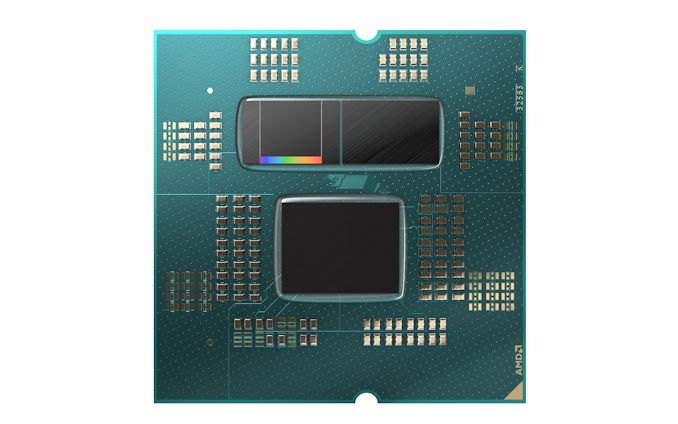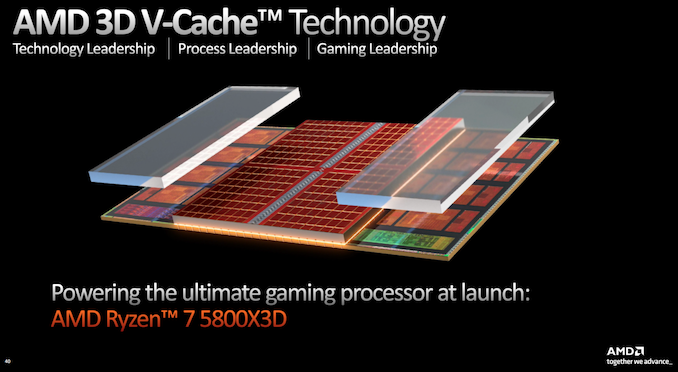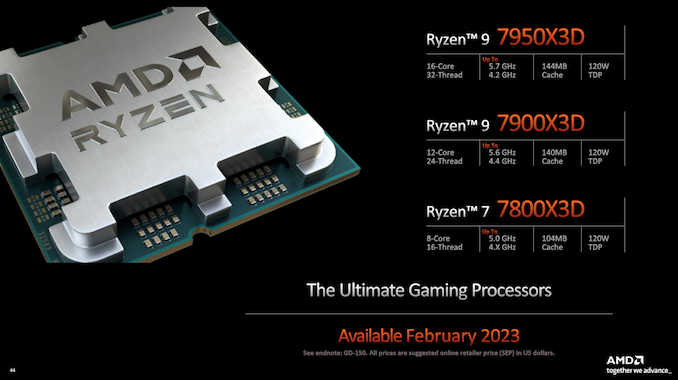AMD Unveils Ryzen 9 7950X3D, 7900X3D, and Ryzen 7 7800X3D, Up to 128 MB of L3 Cache And 5.7 GHz Boost
by Gavin Bonshor on January 4, 2023 10:31 PM EST
During Computex 22, AMD showcased its updated CPU roadmap going through 2024, which yielded some exciting propositions to the desktop processor market. One of those products highlighted was a new 3D V-Cache SKU based on Zen 4 cores, and with the success of its previous Ryzen 7 5800X3D with 96 MB of 3D stacked V-Cache, gamers have been chomping at the bit for more ever since. Using their primetime keynote slot during CES 2023, AMD has unveiled its next 3D V Cache-based processors to the market using its Zen 4 core architecture.
AMD hasn't unveiled just one new Zen 4-based X3D SKU; it's announcing three across the Ryzen 7000 series, the Ryzen 9 7950X3D, the Ryzen 9 7900X3D, and the Ryzen 7 7800X3D. Aside from 64 MB of additional L3 cache through AMD's 3D V-Cache stacking technology, which is a 3D chiplet stacking technology in conjunction with TSMC, all three Zen 4 X3D SKUs feature a 120 W TDP. They also have higher boost core frequencies than previous X3D chips, with the Ryzen 9 7950X3D boosting up to an impressive of 5.7 GHz on the core.
AMD and 3D Chiplets: Stacking L3 Cache For Gamers
Since AMD released its first desktop processor featuring its 3D V-Cache packaging technology, the Ryzen 7 5800X3D, it has given users and gamers a taste of the benefits that large pools of L3 cache can have on framerates in CPU-limited scenarios. Focusing on the previous Ryzen 7 5800X3D, AMD and TSMC added 64 MB SRAM chiplet onto the top of the existing 32 MB through a direct copper-to-copper bonding TSV to ensure circuit integrity.
The method includes die thinning, intending to enable parity between the 3D stacked chiplet, the rest of the silicon, and the integrated heat spreader (IHS) so that it fits within the same overall platform frame, e.g., cooler and compatibility. As the Ryzen 7 5800X3D and its 96 MB of stacked L3 V-Cache displayed significant improvements in specific titles, the extra L3 cache didn't provide that performance gain in other titles; there still isn't an official list of games that benefit from extra L3 cache.
The main caveat with the Ryzen 7 5800X3D came through its compute performance. With slower overall core clock speeds than the Ryzen 7 5800X, it suffered in tasks such as rendering, encoding, and any task or workload that didn't benefit from large amounts of L3 cache. It looks as though AMD considered that and did it better.
Below is a list of our detailed coverage of AMD's Ryzen 7000 desktop processors and its 3D V-Cache packing technology:
- AMD Zen 4 Ryzen 9 7950X and Ryzen 5 7600X Review: Retaking The High-End
- AMD's Desktop CPU Roadmap: 2024 Brings Zen 5-based "Granite Ridge"
- AMD Zen Architecture Roadmap: Zen 5 in 2024 With All-New Microarchitecture
- AMD Zen 4 Update: 8% to 10% IPC Uplight, 25% More Per-Per-Watt, V-Cache Chips Coming
- AMD Demonstrates Stacked 3D V-Cache Technology: 192 MB at 2 TB/sec
Ryzen 9 7950X3D: New Flagship For Gaming with 128 MB L3 Cache, Up to 5.7 GHz
AMD has gone all out with its 3D V-Cache packaging technology with the announcement of AMD Ryzen 9 7950X3D, a 16-core, 32-threaded behemoth with 128 MB of L3 cache, and a boost core clock speed of up to 5.7 GHz. While we saw some concessionary trade-offs between the previous generation Ryzen 7 5800X3D in computation performance, this was explained by lower voltages, necessitating a lower core base frequency and a lower core boost frequency. Consequently, pure CPU compute performance declined in contrast to the Ryzen 7 5800X.
The latest Ryzen 7000 X3D SKUs look to alleviate much of the previous discrepancies in performance like we saw with the Ryzen 7 5800X3D and 5800X, by allowing for similar peak turbo clock speeds without interfering with the integrity of the stacked silicon in the 3D V-Cache stack.
We have reached out to AMD to confirm how they managed to secure the integrity with a much greater boost clock speed than the previous Ryzen 7 5800X3D. Still, with the efficiency of TSMC's 5 nm node and performance-per-watt upgrade with AMD's Zen 4 core architecture over the 7 nm Zen 3 core, we believe this combination is one of the reasons how they managed it. We have also reached out to AMD on whether or not the Ryzen 7000 X3D processors are unlocked or if overclocking via the frequency multiplier is disabled. Once we receive a reply, we will update this piece with their response.
Opening with the flagship SKU, the Ryzen 9 7950X3D shares many of the same characteristics as the Ryzen 9 7900X, including 16-cores and 32-threads and a turbo frequency of up to 5.7 GHz. The enhanced chip offers 128MB of L3 cache, which is comprised of 64 MB of existing pooled L3 cache in the CCDs, and another 64 MB sliced on top with TSVs (presumably placing 64MB on one CCD, creating an unbalanced cache). Curiously, the official TDP is also much lower, with the chip rated at 120 W versus 170 W for the regular 7950X. Consequently, the 7950X3D has a lower base core frequency of 4.2 GHz, versus 4.5 GHz. Although the Ryzen 9 7950X3D has a 300 MHz slower base frequency, having the same turbo frequency of 5.7 GHz means that peak performance can be similar, though in heavily multithreaded situations the lower TDP is undoubtedly going to come into play.
| AMD Ryzen 7000X/X3D Series Line-Up | |||||||
| AnandTech | Cores Threads |
Base Freq |
Turbo Freq |
Memory Support |
L3 Cache |
TDP | MSRP |
| Ryzen 9 7950X | 16C / 32T | 4.5 GHz | 5.7 GHz | DDR5-5200 | 64 MB | 170 W | $699 |
| Ryzen 9 7950X3D | 16C / 32T | 4.2 GHz | 5.7 GHz | DDR5-5200 | 128 MB | 120 W | TBD |
| Ryzen 9 7900X | 12C / 24T | 4.7 GHz | 5.6 GHz | DDR5-5200 | 64 MB | 170 W | $549 |
| Ryzen 9 7900X3D | 12C / 24T | 4.4 GHz | 5.6 GHz | DDR5-5200 | 128 MB | 120 W | TBD |
| Ryzen 7 7800X3D | 8C / 16T | TBD | 5.0 GHz | DDR5-5200 | 96 MB | 120 W | TBD |
| Ryzen 7 5800X3D | 8C / 16T | 3.4 GHz | 4.5 GHz | DDR4-3200 | 96 MB | 105 W | $449 |
AMD is competing at the top end of the x86 desktop market with its 16-core offerings, both in compute and gaming. Still, AMD has also readied a 12-core solution with their X3D chiplet packaging technology, the Ryzen 9 7900X3D. Sitting alongside the Ryzen 9 7900X in the stack, the Ryzen 9 7900X3D has double the L3 cache (128 vs. 64 MB) and the same 4.4 GHz boost core clock speed. The only differences come in the way of base frequencies and power consumption, with the Ryzen 9 7900X3D having the same 120 W TDP as all of the new Ryzen 7000 X3D-based SKUs, which as a consequence, does drop the base core frequencies down from 4.7 GHz to 4.4 GHz; a 300 MHz drop on base.
Ryzen 7 7800X3D: Like the Ryzen 7 5800X3D, But Better
The final and third X3D SKU is the Ryzen 7 7800X3D processor, the direct successor, and replacement to the previous Ryzen 7 5800X3D. Sharing the same large 96 MB of L3 cache, AMD has improved the specifications with a faster boost core clock speed of up to 5 GHz, along with the residual benefits that AMD's Zen 4 TSMC 5 nm core brings to the table in both performance, IPC uplift, and performance-per-watt efficiency.
AMD has also provided their in-house figures on the Ryzen 9 7800X3D versus the Ryzen 7 5800X3D, including a claimed 21% uplift in performance at high 1080p settings, 22% in Warhammer Dawn of War 3, and 23% in CS: GO framerates. Further to these performance claims, AMD claims that the Ryzen 9 7800X3D has an uplift of 30% in DOTA 2. AMD hasn't provided any in-house data surrounding compute performance or gaming performance data for the Ryzen 9 7950X3D or Ryzen 9 7900X3D processors.
All three of AMD's latest X3D-based 3D V-Cache packaged processors, including the Ryzen 9 7950X3D, the Ryzen 9 7900X3D, and the Ryzen 7 7800X3D, will be available in February 2023. Although it hasn't provided information surrounding the expected MSRP of each CPU, the Ryzen 7 5800X3D came with a $100 premium over the regular Ryzen 7 5800X. We expect that there will be at least a similar price premium.
With price drops already in force for the non-X3D SKUs already on the market, such as the Ryzen 9 7900X, there could be room for the Ryzen 7000 X3D SKUs to slot in at the original MSRPs of each corresponding processor in the family.




















48 Comments
View All Comments
quaz0r - Friday, January 6, 2023 - link
My good sir, your myopia is unparalleled.evilspoons - Friday, January 6, 2023 - link
"Champing" at the bit, not "chomping". Heh.Oxford Guy - Saturday, January 14, 2023 - link
Quite.Bruzzone - Saturday, January 7, 2023 - link
I have completed my audit across the web that began here on January 4 when I found shing332 "ccd cross latency" observation of interest as well as "thread directed" ccd application optimization Cooe, brucethemoose, Tomwomack (is this SF sailor TW the 1980s ingot broker) and Espinosidro conferred.haukionkannel stated a cost estimate and I will end with data supporting my R7K 3D cost : price determination.
At 5800X3D my observations limiting 3D to 5800X were cost and heat associated x2 ccd subject same package area and in relation Ryzen if Ryzen 3D the same special (under Fujitsu license KamW told me in 2017) package material as TR/Epyc subject heat transfer tolerance. I queried Hallock on a live stream specific my thoughts and was informed power management would address 5800X3D heat in package adding 64 MB SRAM $ and that seems the case on power management which Hallock pointed at the time. I will rule out heat as a two SRAM add concern.
Like many I did not see 64 MB SRAM add coming to one ccd on 79x0XT3D but understood the cost and validation impact of adding x2 xx MB SRAM including the cost of failing qualification.
I buy AMD's reasoning adding one 64 MB $ slice tightly coupled to one ccd for loading simulations while enabling alternate ccd for high frequency. Which presents a question. There is no hexa 7600X3D, maybe because on cache per core subject price it might cannibalize into 7800X3D sales having 33% more L3 per core as 3600/5600 demonstrate. Alternative thought is SRAM add on interconnect placement can only be added to an octa ccd? This would mean that 7900X3D is 8C+4C avoiding the cost of wasting one good hexa ccd? Next question moves into performance aspects of 8C+L3$ add + 4 C for frequency ccd?
The next find relates to the ccd's themselves and the cross latency and bus contention question. In Kevin Krewell, "RISC-V Summit 2022: All Your CPUs Belong to Us", EE Times, 1.4.22, the Trias analyst (former AMD) notes, "the V1 (Risc V) chiplet architecture is similar to AMD’s EPYC processors, but Ventana differs in some significant ways. The chiplet connection to the memory and I/O hub uses a very low latency interface called “Bunch of Wires” (BoW) developed by the Open Compute Project in the Open Domain-Specific Architecture (ODSA) sub-project. BoW is a parallel interconnect and does not use higher-latency SerDes connections like AMD’s Infinity Fabric to convert parallel interfaces to serial, introducing latency. Although the company is using BoW today, it does plan to use UCIe in the future.
The key is SerDes to get on and off Infinity fabric between each 79x0XT3D ccd is what caught my attention specific latency and bus contention. Specific Win 11 optimization I also bumped into a comment string noting Intel Management Engine performing some RL/AL hypervisor functionality?
Finally on my cost : price estimate, first consider the full line supply data as a proxy for production;
7950X 16C = 33.4% of WW channel supply
7900X 12C = 34.2% note on a total revenue basis 67.7% are x2 ccd components
7700X 8C = 14.6%
7600X 6C = 17.7%
Now I can normalize silicon area across the full line. I will not get into the precision of whether or not 7900X is x2 hexa or 8C + 4C specific cost, a full ccd is a full ccd. Or cost difference between 5 nm ccd and 6 nm i/o my presentation here is 'all up'.
79x0_ = 261 mm2 (70*2 cd +121 i/o)
77/7600_ = 191 mm2 (70*1 + 121)
The normalized area across full line production is 237.74 mm2 of die area which by the way is a historically relevant Intel desktop area sweet spot.
Now to determine cost and again I will make this simple, rather than estimating bottom up TSMC cost per mm2 or area subject 'design production' cost incorporating OpEx, I will rely on AMD cost : price / margin.
TSMC price to AMD is determined stakeholders / 3; TSMC, AMD, OEM. In this square / 3 component total value deal everyone splits the value for no arguing. On the production by grade SKU (that is actually the supply split proxy for production) R7K $1K average weighed price on original MSRP is $533.06 / 3 stakeholder is $177.69 TSMC price to AMD before AMD to OEM mark-up.
Now, how much cost add is 64 MB SRAM L3 $. Looking at the photo 64 MB slice is approximately 2/3rd of one 70 mm2 cdd or 46 mm2. On R7K normalized area design production cost is 237 mm2 / 177.69 = $0.75 cents per mm2 of component area all up. 64 MB SRAM slice adds $34.53 to the cost of producing one R7K 3D = $212.19. Note 64 MB 5 nm SRAM slice is basically $5 more than 5800X3D 64 MB 32 mm2. On that reference TSMC 5 nm price to AMD over 7 nm is + 16.6%. The next question is that 64 MB slice 5 nm and my answer is maybe not on captive charge endurance and interconnect pitch that I presume is silicon facing silicon . . . was it, IBM that invented that? What's it called?
So what will R7K 3D price be to the OEM on a full product line procurement mirroring percent by core grade coming out of production. To get to this price traditionally its total production volume / first tier customer split equals the minimum unit commitment. Here I will calculate at AMD's q3 2022 + 50% margin take but under gross margin pressure it might now be + 60%? AMD price to OEM is ($177.69 + $34.50 = $217.19 + AMD mark-up) range $318.28 to $339.50 and AMD as a profit maximizer the low volume price is x2 cost or $385.38 per unit.
Now what is the retail price and I provide that estimate for each SKU
7950X3D = $802.50 or $799 ($699 / 3 = $233 + 34.50 * 3 = $802.5
7900X3D = $652 or $649
7800X3D = $502 or $499
If a 7600X3D is possible = $402 or $399
Note price estimates do not incorporate any end seller price premium. Also, haukionkannel and my price estimate are roughly in the same ball park.
I have speculated R7K and RL are all Extremes and we'd see the top bin EE $999 price point but not officially and one reason is Intel continues to low ball Raptor price on in house manufacturing cost advantage goosing retail with up to 100% margin potential through the holidays where AMD at retail is approximately + 30%.
Noteworthy on channel data current desktop and mobile sales trend back to Coffee Lake finds Intel desktop and mobile selling in relation to AMD at 1.24 Intel to 1 AMD ratio and between Raptor + Alder and Raphael + Vermeer desktop only at a 1 to 1 ratio.
Mike Bruzzone, Camp Marketing
Bruzzone - Saturday, January 7, 2023 - link
Whoops transposition (if Q comes by) correction $177.69 / 237 mm2 = $0.75. mbnandnandnand - Saturday, January 7, 2023 - link
Interesting idea about 8+4 7900X3D. We'll find out in February.I just realized the 7000X3D CPUs have the iGPU. It would be funny to see a performance boost in integrated graphics performance from the big cache.
Bruzzone - Monday, January 9, 2023 - link
nandnandnand, R7K iGPU boost from big cache? Not sure for what . . ."The iGPU on the AMD Ryzen 7000 CPUs will feature 2 Compute Units for a total of 128 stream processors. These cores will run at a base clock speed of 400 MHz and a graphics frequency of 2200 MHz which could be the peak frequency. Offering up to 0.563 TFLOPs of 563 GFLOPs of compute power, this will deliver slightly better performance than the Nintendo Switch which is rated at 500 GFLOPs" reports Hassan on 9.7.22
I'm still waiting for Intel to substantiate E cores are relied on applications compilation as a SIMD (parallel processing) array? Seems may be . . .
Hard to say without applications development guide. Not sure why they are not public anymore?
mb
lopri - Tuesday, January 17, 2023 - link
iGPU is in the I/O die and V-cache is with a chiplet, so iGPU boost is not likely.